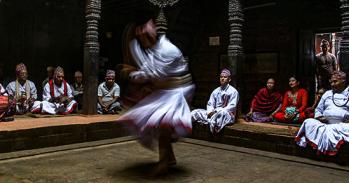
Tomorrow we launch a series of 12 articles by Cambridge researchers who tell us about the unfamiliar places where they’ve spent the night in the course of their work. Introducing the Extreme Sleepover series, distinguished anthropologist Professor Dame Caroline Humphrey reflects on how fieldwork not only enriches researchers' work but also touches their hearts and minds.
Tomorrow we launch a series of 12 articles by Cambridge researchers who tell us about the unfamiliar places where they’ve spent the night in the course of their work. Introducing the Extreme Sleepover series, distinguished anthropologist Professor Dame Caroline Humphrey reflects on how fieldwork not only enriches researchers' work but also touches their hearts and minds.
The extreme can be a purely physical test but, when it involves experiencing the lives of other people, the notion has to be seen as relative: what appears extreme to one person is normal for another.
Professor Dame Caroline Humphrey
Each one of the dozen reports contributed by Cambridge researchers is fresh and vivid; they tell us in their own words what field research is really like. I have travelled extensively in the course of my work. Yet it was a revelation to me that such a wide range of scientific research involves being there, putting oneself on the line whatever the conditions in order to learn more about your subject. This kind of work cannot be done in labs or libraries. What makes these accounts so fascinating is that they show how diverse are the demands of fieldwork, stretching human capacities in quite different ways.
To mention just a few contributors to the series by name: scientist and medic Dr Ak Reddy monitors his own circadian rhythms while working through the night in hospital; physiologist Dr Andrew Murray takes his own and colleagues’ blood oxygen levels, and tests basic cognitive functions, at Everest Base Camp; historian Catherine Porter uses her knowledge of the KiSwahili language to interview the people of Katanga in the Democratic Republic of Congo; and Dr Gabriela Ramos, also a historian, melts into the crowds to experience the burst of joy unleashed by a religious festival high up in the Andes. In each case, it is the research itself that makes the demands and puts the researcher to the test.
What also strikes me in these accounts is how vital it is for the researcher to have ability to cope with whatever comes their way. Who would guess that embarking on a career in earth sciences would involve staking out one’s tent against a possible visit from polar bears, as geologist Marian Holness describes so well? Or that Robert Hird, an engineer investigating inland saline deposits, would find himself spending a night squatting by a Soviet-era gas crater, mesmerised by its hissing flames? Though the authors don’t labour the point, one has the feeling that each of them has learned something about himself/herself through these experiences – and that they are all the more intense and memorable precisely because they were so unexpected.
The title of the series makes me think about the word ‘extreme’ and what it means in the widest sense. It brings to mind exploration and whatever is beyond the mapped and known. The extreme can be a purely physical test but, when it involves experiencing the lives of other people, the notion has to be seen as relative: what appears extreme to one person is normal for another. In my own subject, social anthropology, suggesting that the field site is somehow extreme is generally speaking a big no-no.
The aim of the social anthropologist is to adjust as far as possible to life in the research setting, however distant or dangerous for the incomer. What might at first seem extraordinary becomes through long fieldwork ordinary, even boring, and the idea is that only when this adaptation has been achieved can one gain the best insight into the ways of thinking and acting in other societies. In the profession it is almost a moral duty not to paint as extreme the conditions other people have to live with every day.
Yet for all that, the idealised conditions that anthropologists impose on themselves – specifically the exclusion of the language of ‘the extreme’ - are in the end impossible to achieve. The ‘extreme’ and ‘remote’ may be close at hand, if only we notice them. Incredulity and marvel are part of research. When human subjects are concerned, the process is two-way. In the report contributed by architectural engineer Michael Ramage, we see that just as Europeans were amazed at the discovery of an ancient royal palace with its exquisite golden rhinoceros, so the African workmen were incredulous that an architect’s vaults of fragile soil tiles could actually bear their weight.
Professor Dame Caroline Humphrey
Caroline, an anthropologist, founded and directs the Mongolia and Inner Asia Studies Unit (MIASU) at the University of Cambridge. In the course of her career she has conducted extensive research in the USSR (Siberia), Nepal, India, Mongolia, China (Inner Mongolia), Uzbekistan and Ukraine, and was one of the first anthropologists from a western country to be allowed to do fieldwork in the USSR. She was awarded a DBE for services to scholarship in the 2010 New Year Honours list.
This work is licensed under a Creative Commons Licence. If you use this content on your site please link back to this page.




